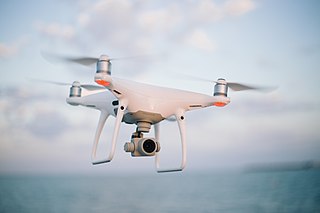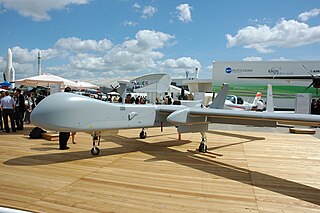
An unmanned aerial vehicle (UAV) is an aircraft without a human pilot on board and a type of unmanned vehicle. UAVs are a component of an unmanned aircraft system (UAS); which include a UAV, a ground-based controller, and a system of communications between the two. The flight of UAVs may operate with various degrees of autonomy: either under remote control by a human operator or autonomously by onboard computers.

Precision agriculture (PA), satellite farming or site specific crop management (SSCM) is a farming management concept based on observing, measuring and responding to inter and intra-field variability in crops. The goal of precision agriculture research is to define a decision support system (DSS) for whole farm management with the goal of optimizing returns on inputs while preserving resources.

Robert Bosch GmbH, or Bosch, is a German multinational engineering and technology company headquartered in Gerlingen, near Stuttgart, Germany. The company was founded by Robert Bosch in Stuttgart in 1886. Bosch is 92% owned by Robert Bosch Stiftung.
Draper Laboratory is an American not-for-profit research and development organization, headquartered in Cambridge, Massachusetts; its official name is "The Charles Stark Draper Laboratory, Inc". The laboratory specializes in the design, development, and deployment of advanced technology solutions to problems in national security, space exploration, health care and energy.

Swarm robotics is an approach to the coordination of multiple robots as a system which consist of large numbers of mostly simple physical robots. It is supposed that a desired collective behavior emerges from the interactions between the robots and interactions of robots with the environment. This approach emerged on the field of artificial swarm intelligence, as well as the biological studies of insects, ants and other fields in nature, where swarm behaviour occurs.

The Lockheed DC-130 was a variant of the C-130 Hercules, designed for drone control. It could carry four Ryan Firebee drones underneath its wings.

A coordinate measuring machine (CMM) is a device that measures the geometry of physical objects by sensing discrete points on the surface of the object with a probe. Various types of probes are used in CMMs, including mechanical, optical, laser, and white light. Depending on the machine, the probe position may be manually controlled by an operator or it may be computer controlled. CMMs typically specify a probe's position in terms of its displacement from a reference position in a three-dimensional Cartesian coordinate system. In addition to moving the probe along the X, Y, and Z axes, many machines also allow the probe angle to be controlled to allow measurement of surfaces that would otherwise be unreachable.

The Nikon D200 is a 10.2-megapixel digital single-lens reflex camera that falls between entry-level/midrange DSLR cameras such as the Nikon D40, Nikon D40x, and D80 and high-end models such as the Nikon D2Hs and D2Xs. It was released by the Nikon Corporation in November 2005. The D200 was succeeded by the D300 in August 2007.

Topcon Corporation is a Japanese manufacturer of optical equipment for ophthalmology and surveying.

A quadcopter, also called a quadrotor helicopter or quadrotor, is a multirotor helicopter that is lifted and propelled by four rotors. Quadcopters are classified as rotorcraft, as opposed to fixed-wing aircraft, because their lift is generated by a set of rotors.
The Guidance, Control and Decision Systems Laboratory (GCDSL) is situated in the Department of Aerospace Engineering, Indian Institute of Science, Bangalore, India. The Mobile Robotics Laboratory (MRL) is its experimental division. They are headed by Dr. Debasish Ghose, Full Professor.
Automated aerial refueling (AAR) refers to methods for autonomous refueling of manned and unmanned aircraft.

The EADS Harfang, formerly known as Système intérimaire de drone MALE is a drone system used by the French Air Force, supplementing the RQ-5 Hunter.

An inertial navigation system (INS) is a navigation device that uses a computer, motion sensors (accelerometers) and rotation sensors (gyroscopes) to continuously calculate by dead reckoning the position, the orientation, and the velocity of a moving object without the need for external references. Often the inertial sensors are supplemented by a barometric altimeter and occasionally by magnetic sensors (magnetometers) and/or speed measuring devices. INSs are used on vehicles such as ships, aircraft, submarines, guided missiles, and spacecraft. Other terms used to refer to inertial navigation systems or closely related devices include inertial guidance system, inertial instrument, inertial measurement unit (IMU) and many other variations. Older INS systems generally used an inertial platform as their mounting point to the vehicle and the terms are sometimes considered synonymous.
Jugnu, is an Indian technology demonstration and remote sensing CubeSat satellite which was operated by the Indian Institute of Technology Kanpur. Built under the guidance of Dr. N. S. Vyas, it is a nanosatellite which will be used to provide data for agriculture and disaster monitoring. It is a 3-kilogram (6.6 lb) spacecraft, which measures 34 centimetres (13 in) in length by 10 centimetres (3.9 in) in height and width. Its development programme cost around 25 million rupee. It has a design life of one year.

NIRA Dynamics AB is a Swedish company focusing on research and development of signal processing and control systems for the automotive industry. It supplies automotive original equipment manufacturers (OEMs) and suppliers in Europe, North America, Latin America, and Asia with its products and systems. In 2015, the number of vehicles equipped with NIRA's main product, TPI, exceeded the benchmark of 15,000,000.
ArduPilot is an open source, unmanned vehicle Autopilot Software Suite, capable of controlling autonomous:
Walkera UAVs are micro air vehicles (MAV) developed by Guangzhou Walkera Technology Co., Ltd.. Walkera, founded in 1994, is located at the center of the Pearl River Delta's Panyu District of Guangzhou and is made up of 1500 staff. Traditionally, Walkera is an established Chinese manufacturer of remote control hobby helicopters, but the company has expanded its business to UAVs by starting with MAV production, based on its successful remote-control hobby helicopter business. Most MAVs developed by Walkera are equipped with daytime color TV camera, but none of them are in the helicopter configuration of the usual Walkera remote control models. Most of the multirotors MAV were originally developed for commercial and consumer use, but have been deployed by Chinese military and law enforcement agencies as trainers for more advanced and costly UAVs deployed in longer missions. In 2011, Walkera made famous the first commercially available 6-axis microcopter, called the Ladybird. This number one seller soon caught the attention of various manufacturers and copies of the Ladybird followed.
AltiGator is a multirotor unmanned aerial vehicle manufacturer founded in 2008 and headquartered in Waterloo, Walloon Brabant, Belgium. It produces complete ready-to-fly radio-controlled miniature UAVs for various professional applications. It also holds a web-shop providing spare parts, self-assembly kits and accessories for drones.














